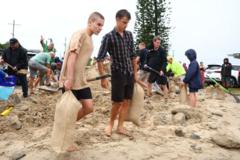As Cyclone Alfred, now downgraded to a tropical low, inches towards Queensland's eastern coastline, authorities anticipate significant flooding and severe weather conditions. The storm, which was initially expected to bring stronger winds, is now forecasted to produce gusts up to 85 km/h. With tens of thousands forced to evacuate and over 230,000 households currently without electricity, the Bureau of Meteorology cautions residents to remain indoors as heavy rains are likely to persist.
The storm, currently located near Bribie Island, is expected to make landfall between the island and Maroochydore. Senior meteorologist Miriam Bradbury reported a potential for rainfall totals exceeding 200mm over the next few days, posing serious concerns for flash flooding, particularly in low-lying areas. Widespread flash-flooding was already observed, with police in New South Wales reporting a search for a missing driver swept away by rising waters.
Residents across Queensland and northern New South Wales are deeply concerned as approximately four million people find themselves in the storm's trajectory. Local authorities have been proactive, distributing sandbags and encouraging preparedness as the storm's slow "walking pace" movement raises apprehensions among the populace. “We’re as ready as we can be for something unprecedented," commented local Logan resident Stephen Valentine as he stocked up on essentials for himself and his pets.
Prime Minister Anthony Albanese has emphasized the resilience of Australians in the face of adversity, acknowledging the rare occurrence of cyclones affecting the southern regions of Queensland. Cyclone Alfred is anticipated to bring excessive rainfall, potentially reaching up to 800mm, as well as strong winds. In anticipation of the storm, nearly 1,000 schools have closed, public transport has been halted, and flights have been suspended, while elective surgeries were also cancelled.
The last major cyclone to hit the region was back in 1974, highlighting the rarity of this severe weather pattern. Community members have expressed a mixture of fear and apprehension about sheltering from the impending storm. Local surfers, however, are seizing the opportunity to catch waves despite the rising winds, indicative of the unique relationship between Australians and their coastal environment.
As the August storm develops, Prime Minister Albanese has urged the public to heed safety warnings and avoid unnecessary risks. "This isn't a time for sightseeing," he advised, emphasizing the seriousness of the situation. As uncertainty looms, communities are bracing for the impending weather as they navigate this challenging period.
The storm, currently located near Bribie Island, is expected to make landfall between the island and Maroochydore. Senior meteorologist Miriam Bradbury reported a potential for rainfall totals exceeding 200mm over the next few days, posing serious concerns for flash flooding, particularly in low-lying areas. Widespread flash-flooding was already observed, with police in New South Wales reporting a search for a missing driver swept away by rising waters.
Residents across Queensland and northern New South Wales are deeply concerned as approximately four million people find themselves in the storm's trajectory. Local authorities have been proactive, distributing sandbags and encouraging preparedness as the storm's slow "walking pace" movement raises apprehensions among the populace. “We’re as ready as we can be for something unprecedented," commented local Logan resident Stephen Valentine as he stocked up on essentials for himself and his pets.
Prime Minister Anthony Albanese has emphasized the resilience of Australians in the face of adversity, acknowledging the rare occurrence of cyclones affecting the southern regions of Queensland. Cyclone Alfred is anticipated to bring excessive rainfall, potentially reaching up to 800mm, as well as strong winds. In anticipation of the storm, nearly 1,000 schools have closed, public transport has been halted, and flights have been suspended, while elective surgeries were also cancelled.
The last major cyclone to hit the region was back in 1974, highlighting the rarity of this severe weather pattern. Community members have expressed a mixture of fear and apprehension about sheltering from the impending storm. Local surfers, however, are seizing the opportunity to catch waves despite the rising winds, indicative of the unique relationship between Australians and their coastal environment.
As the August storm develops, Prime Minister Albanese has urged the public to heed safety warnings and avoid unnecessary risks. "This isn't a time for sightseeing," he advised, emphasizing the seriousness of the situation. As uncertainty looms, communities are bracing for the impending weather as they navigate this challenging period.




















